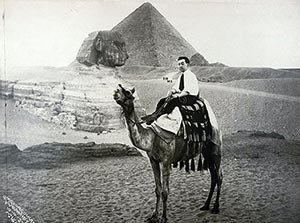Ten milestones of Victor Eusa's architecture in Pamplona
By José Javier Azanza López
|
|
|
|
|
|
|
|
|
|
|
|
|
|
|
|
|
|
|
|
|
|
|
|
|
|
|
|
|
Introduction
Víctor Eusa Razquin (Pamplona, 1894-1990) is one of the most brilliant architects of his generation and the central figure of architecture in Navarre during much of the 20th century. programs of study In the more than five decades that elapsed from the completion of his architectural studies in Madrid in 1920 until his retirement in 1973, he signed hundreds of projects in Navarre, where he concentrated most of his activity, with occasional presence in the neighboring provinces of Zaragoza, Guipúzcoa and Vizcaya, and in cities such as Madrid, Talavera de la Reina and Alcoy.
His architectural activity coincides with the construction of the II Ensanche of Pamplona, the urban area par excellence of Eussen's work, to the point that his buildings become authentic landmarks that characterize the reticular grid designed by the municipal architect Serapio Esparza. In them, "the architect of the capital" captures both his academic training and the various influences he received throughout his prolific degree program, the result of his travels in Europe and the East. All of this materializes in an architecture staff that reaches its maturity in the late twenties and lasts until the Civil War, the period in which his best-known works are dated. After the war, he became the municipal architect of Pamplona and provincial architect of the Diputación Foral de Navarra, opening his work to a new aesthetic and urban proposal .
This tour through some significant examples of Victor Eusa's architecture in Pamplona is based on a diachronic criterion that allows us to verify his evolution. Starting from hesitant beginnings in which the substratum of his academic training welcomes oriental and Viennese Sezession influences (building of "La Vasco Navarra"), he advances towards regionalism (house for Sebastián Goicoechea) until reaching an expressionist language related to art-deco in his most emblematic buildings of rigid geometry and combination of red brick and concrete (Casa de Misericordia, convent and church "La Milagrosa" of PP. Paúles, high school of the PP. Escolapios, housing building of the streets Fernández Arenas / García Castañón) and that in certain cases participate in a marked symbolism (seminar of Pamplona). In this eclecticism displayed by Víctor Eusa in the pre-Civil War period, there is also room for the modern European avant-garde (Casino Eslava) and the imprint of rationalism (Clínica San Juan de Dios).
After the war, Eusa will yield to a greater classicism, without renouncing some of its main hallmarks of the previous period (high school Santa María la Real de HH. Maristas). But regardless of the language, two aspects remain constant in the architect from Pamplona: the consideration of the place with a clear urban vocation, and the attention to the use and function to which the building is destined.
ARAZURI, J. J., Pamplona, calles y barrios, 3 vols., Pamplona, J. J. Arazuri, 1979-1981.
Contemporary architecture in Spain. El arquitecto Víctor Eusa (prologue by J. Polo de Benito), Madrid, Edarba, 1934.
ARRIETA ELÍAS, I., ORBE SIVATTE, A. and RUIZ CABRERO, G., guide de arquitectura de Pamplona y su comarca, Pamplona, high school Oficial de Arquitectos Vasco-Navarro, 2006.
CABALLERO LOBERA, A., Víctor Eusa-Architect: Pamplona 1894-1990. thesis doctoral defended at the E.T.S. Arquitectura de San Sebastián in December 2015. Director: M. Íñiguez Villanueva. https://addi.ehu.es/handle/10810/18576
GARCÍA GAINZA, M.ª C., ORBE SIVATTE, M., DOMEÑO MARTÍNEZ DE MORENTIN, A., AZANZA LÓPEZ, J. J., Catalog monumental de Navarra V***. Merindad de Pamplona, Pamplona, Institución Príncipe de Viana, 1997.
LINAZASORO, J. I., "Víctor Eusa", Nueva forma, n.º 90-91, 1973, pp. 2-37.
MANGADO, M.ª L., "La Pamplona oriental de Víctor Eusa", Diario de Navarra, February 27, 2019, pp. 60-61.
MURUZÁBAL DEL SOLAR, J. M.ª and MURUZÁBAL DEL VAL, J. M.ª, "El escultor Ramón Arcaya", Pregón Siglo XXI, n.º 21, 2003, pp. 1-15.
ORDEIG CORSINI, J. M.ª, design and rules and regulations en la ordenación urbana de Pamplona (1770-1960), Pamplona, Government of Navarra, 1992.
TABUENCA GONZÁLEZ, F., "La obra expresionista de Víctor Eusa", Nueva Forma, n.º 68, 1970, pp. 6-9 and 13-30.
TABUENCA GONZÁLEZ, F., "La arquitectura de Víctor Eusa", Composición Arquitectónica, n.º 4, 1989, pp. 1-12.
TABUENCA GONZÁLEZ, F. (ed.), Víctor Eusa arquitecto (exhibition-homenaje a Víctor Eusa), Pamplona, Pamplona City Council, 1989.
TABUENCA GONZÁLEZ, F., "La arquitectura de Víctor Eusa", Arquitectura. Revista del high school Oficial de Arquitectos de Madrid, n.º 318, 1999, pp. 26-35.
TABUENCA GONZÁLEZ, F., La arquitectura de Víctor Eusa. thesis doctoral defended at the Polytechnic University of Madrid in 2016. Director: R. Moneo Vallés . https://oa.upm.es/40265/1/FERNANDO_TABUENCA_GONZALEZ_01.pdf.
VV. AA., "The work of Víctor Eusa", Arquitectura. Revista del high school Oficial de Arquitectos de Madrid, n.º 137, 1970, pp. 2-31.











